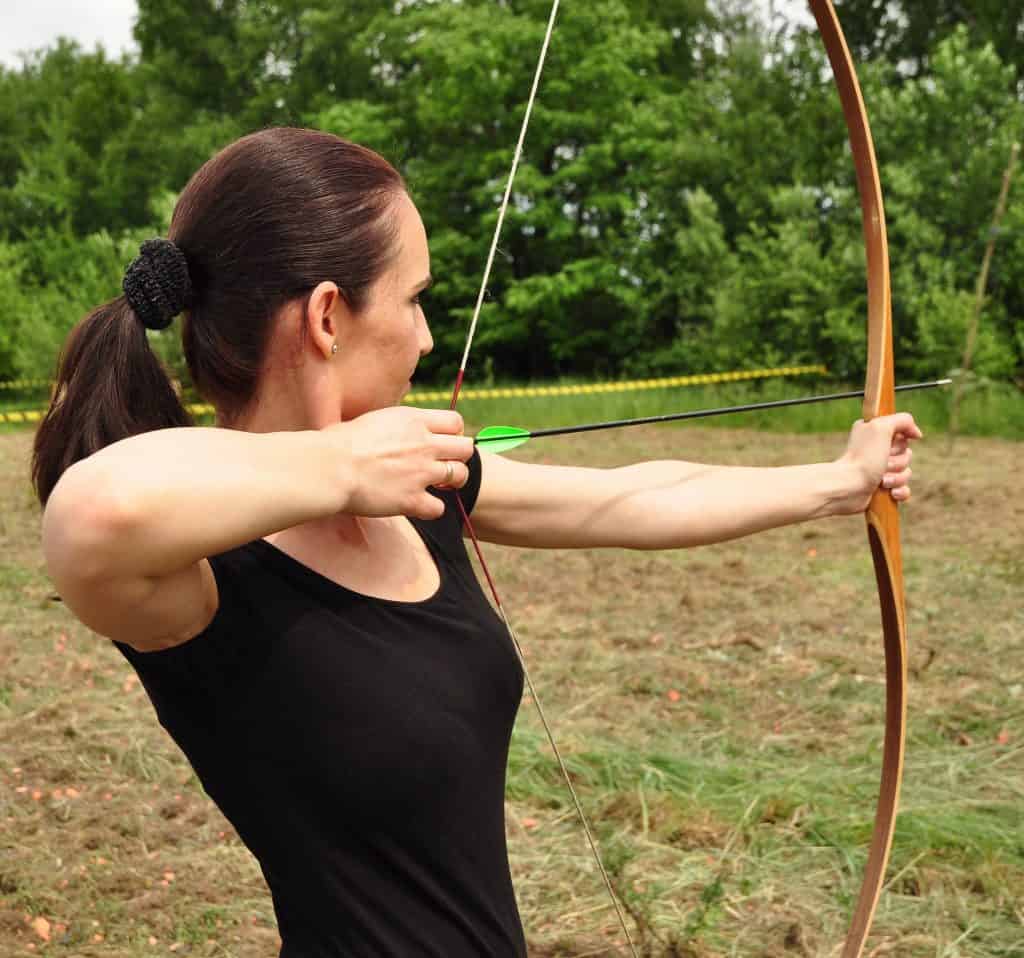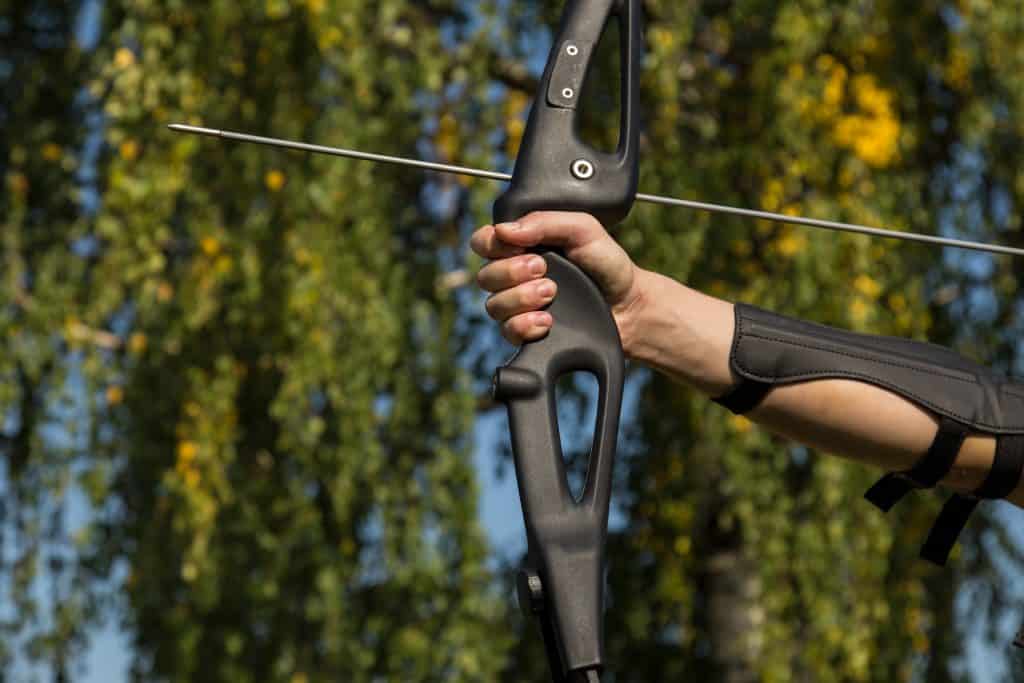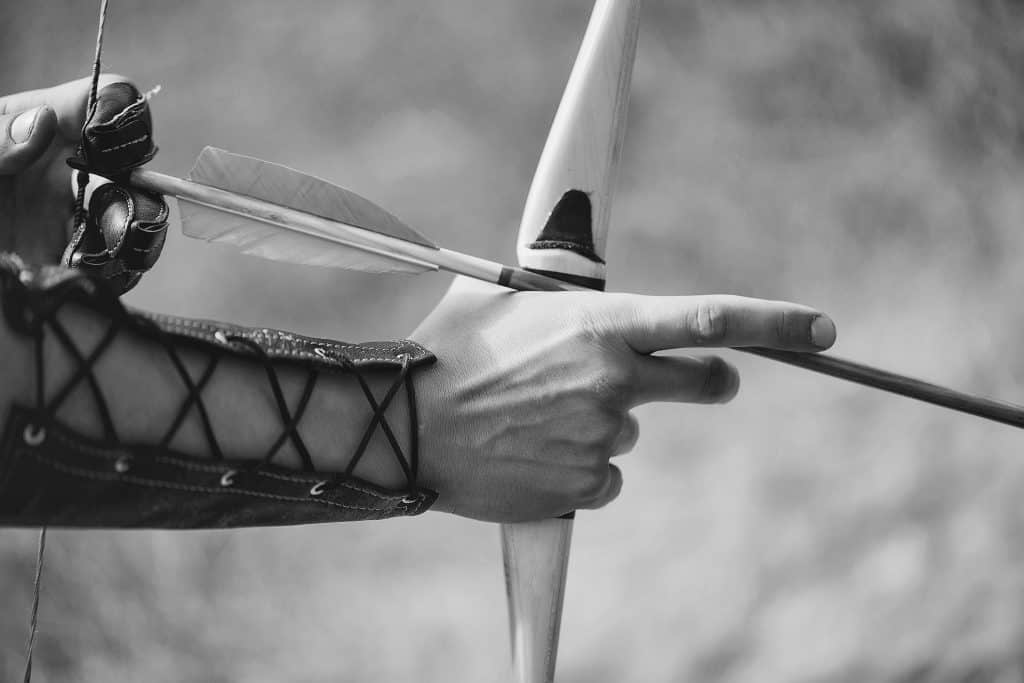
When you’re in the market to buy a long-bow, one of the most important things for you to know is your appropriate draw weight, or what poundage bow you’re going to need in order to have the best experience with your bow.
Finding your correct poundage or draw weight will help prevent cramping, muscle fatigue and soreness, and overall greatly enhance your enjoyment while you’re learning the sport. A draw weight that is too heavy or too light can greatly impact your learning and your desire to continue.
In order to determine the best poundage long-bow, one method, especially if you have some experience with archery, is to shoot 15 pounds lighter than your compound bow draw weight. Another is to find your draw length to find the bow length. For example, a draw length under 24″ requires a bow length of 64″.
These are some of the most common methods that people use in order to determine the correct draw weight/poundage for their long-bows. This article will also discuss a couple of other methods used to find the right draw weight, such as the 30-second test.
We will also talk about ways to improve your draw weight if you’re interested in that, as well as how to know if your bow is too heavy and what to avoid.
The long-bow has been used for thousands of years by civilizations all over the world as a tool during warfare, hunting, and sport. Even today the long-bow is still enjoyed by archers everywhere.
So if you want to experience the feeling of connecting to the archers of the past, and enjoy the raw simplicity and uncomplicated nature of the longbow, I’ve taken the liberty to talk about how to choose the perfect longbow through you, starting with the right draw weight.
How to Determine Proper Draw Weight
As was previously mentioned, there are several different methods that can be used in order to figure out the correct draw weight for you. There are many discussions on which method is the best and most effective way to find the perfect draw weight, but just listen to what your body says and you should be okay!
One of the easiest and quickest ways to find your proper draw weight for your bow is through charts. They’re all over the Internet, and some critics say that since there’s so many, it’s difficult to establish what’s right and what’s not.
Some people talk about your height, or your body weight, or your draw length. I personally don’t find a lot of stock in the charts that talk about your height or your body weight.
My reasoning is that you could be really heavy and tall and not have the right muscles to draw a heavy bow, or you could be small and light and have the right muscles to draw a heavier bow, etc. It varies to each individual.
But the best one I found so far for long-bows was a chart talking about the relationship between draw length and the longbow’s length.
This chart is courtesy of Hunting Bow.com, a site that focuses on all things hunting. Feel free to check this article that talks more into depth about long-bows and their ancient history.
| Draw Length | Bow Length |
| Under 24″ | 64″ |
| 24″ to 27″ | 66″ |
| 27″ to 28″ | 66″ to 68″ |
| 28″ to 30″ | 68″ – 70″ |
| 31″ + | 70″ – 72″ |
And if you don’t really know how to determine your draw length, that’s perfectly fine! That’s also fairly easy to measure.
Have a friend, or maybe a technician at an archery pro shop help you with this part, because you will need to have your armspan be measured from one side to the other, fingertip to fingertip.
Then divide that number by 2.5, round that number up, and you’ll have your draw length!
Some people might argue that draw length shouldn’t be as important, because we’re trying to ascertain draw weight, and that is one of the flaws with this particular chart, but this is a good start to finding your draw weight for your long-bow.
Another method can be best used for those who have already had some experience with archery, and know their draw weight for compound bows. If you know your draw weight for a compound bow, shoot a draw weight for long-bows that is 15 pounds less.
If you don’t know your draw weight for compound bows, here is another simple chart that shows the relationship between your body weight and age and what draw weight is best for you. (even though I don’t think that this is the best way there is)
| Body Type | Suggested Draw Weight |
| Small child (40 to 70 lbs.) | 10 – 15 lbs. |
| Child (70 to 100 lbs.) | 15 – 20 lbs. |
| Women and large-framed boys (100 to140 lbs.) | 30 – 40 lbs. |
| Women with a larger frame & youth boys (140 to 160 lbs.) | 40 – 50 lbs. |
| The majority of males (160 to 190 lbs.) | 55 – 60 lbs. |
| Larger males (190+lbs.) | 65 – 70 lbs. |
Courtesy of Compound Bow (Source)
The method that I like the best, however, is the 30-second test.
Basically what the 30-second test is, is pulling a bow back at full draw and holding that draw and position for a period of 30 seconds.
Sometimes when you go into a pro shop or supply store and are looking to buy a new bow, it’s pretty easy to pick a bow up, draw it once, and declare that your bow weight because it’s pretty easy to draw back.

However, normally in archery, you don’t just shoot your bow once and you’re good.
You might be practicing shooting targets for a couple of hours, or maybe you are shooting during a competition. You might be gone hunting all day in the wilderness, during the pouring rain, the sweltering heat, or the freezing snow.
And the last thing you’re gonna want is a draw weight that’s too heavy for you. Cause trust me, it’s gonna hurt if it’s not the right draw weight. You and your screaming muscles are going to regret it later.
Since we use so many different muscles in our back, shoulders, and arms during archery that aren’t worked too often, it’s very easy to get sore in that area.
So if you’ve tried the 30-second test with a certain bow, and you can’t handle it for 30-seconds, you’re not going to be able to handle it for several hours. Put that bow back down.
How to Know When You Over-Bow
Something really interesting about long-bows, and you’ll know once you’ve picked them up, is that they’re pretty dang heavy.
Back in the ancient days of the infamous English Longbow archers, often they had a draw weight of 160 to 180 lbs. Those guys were not messing around. Not to mention that the bows were sometimes as long as 6 ft and 11 inches.
Well, most people nowadays don’t wield bows that have draw weights of 180 lbs., however, there are still people who pick a larger weight than they really need to have. And they might not even know it!
But there are a couple of signals that the draw weight that you’ve picked is too heavy for you, sometimes known as “over-bow”-ing, so that you can switch to a bow more suited for your strength and ability.
One red flag is that you’re having to aim your bow skyward in order to pull it back at full draw. If you can’t pull the bow back at full length while aiming it level at your target, you know the bow is too heavy for you.
Another one is pulling the bowstring towards your waist, or shaking when you’re pulling the bow at full draw, which is what the 30-second draw weight test is for.
You could be collapsing your shoulder in to pull the string all the way. You could be incredibly exhausted from a simple round of shooting.
All of these are signals that your chosen draw weight is simply too much.
Another test that you can try to confirm whether or not you’re drawing too much weight, is bending at the waist and aiming the bow at the ground just at the inside of your knee. If you can’t do that, it’s clear that the bow’s draw weight is too heavy for you.
So if you see any of these signals, do yourself a favor and fix your bow! Either get a new bow or adjust the draw weight accordingly.
Draw Weight Ego

Now, I want to rant a little bit about a subject that I feel very passionate about. Sometimes when people are looking for a new bow, and they’re discussing their draw weight, it can become a bit of a competition.
It can be very easy to get caught up in the draw weight competition that some archers can feel. Some people compare their draw weights to others, similarly to how some compare how much they can lift or bench at the gym.
However, archery really isn’t a strength sport. Obviously, being strong will get you a higher draw weight, which can have its own advantages. For example, in order to take down big game, you will need a higher draw weight to be able to deliver the force that will make your kill.
However, if you think about it, if your goal in archery is to shoot competitively in target competitions, does it really matter if you have a cool higher draw weight? You’re probably not going to need as heavy as a bow as you might need if you’re bow hunting.
Not to mention that hunters are going to need a bow that delivers enough force so it can travel farther distances and still meet its intended mark. Field archers are going to be shooting at much closer distances.
And in the end, what’s important is not the draw weight of the bow, but if the arrow delivered by the bow makes its mark. Accuracy is really what matters in archery.
And if you’re thinking about purchasing a long bow, lucky for you, longbows actually tend to be more accurate than other bows.
The reasoning is, the body of the bow is technically thinner in width than other bows, but the actual body of the bow is much heavier. Because the body of the bow is heavier, the bow naturally corrects mistakes and miscalculations that would normally result in a less accurate shot.
And because the body is heavy, it prevents torque, which is common in lighter bows, which then again affects the speed and accuracy of your arrows.
So really, in the end, don’t feel bad if you’re not at the point of a higher draw weight as some of your fellow archers are. What’s really important is how you execute your shot, rather than straining all your muscles in order to look strong.
NUSensei, one of my favorite YouTubers on archery, has a fantastic video talking about choosing your correct draw weight and echoes a lot of my similar thoughts about draw weight egos. Check it out!
The Right Way to Increase Draw Weight
So while just having a heavier draw weight in order to look cool isn’t good, like I said before, heavier bows are more accurate and can deliver more force when used correctly.
And if you want to improve your strength and fitness for the purpose of being strong, fit, and healthy, there’s no problem with that!
Another false statement that you might hear in association with the draw weights of bows is, “Oh you’ll grow into your bow.”
Obviously, you can get stronger, but you don’t want to make yourself miserable by forcing yourself to shoot a bow that’s out of your strength capabilities. That’ll just make you hate the actual sport.
One of the better things you can do to increase draw weight is to, first of all, practice with a bow that has your correct draw weight. If you’re new to archery, it’s especially important to get used to using the bow in general.
Once you feel like you’re well accustomed to your original draw weight, you may certainly move up draw weights!
It’s always good to also do strength exercises and exercises that will work your upper body and the many muscles that drawing a bow uses.
Long Bows Versatility
When thinking about changing draw weights and getting up to higher draw weight, you may want to consider this.

The longbow is praised by the archery community because of it’s simple and uncomplicated design. It’s more or less, a stick and a string.
Obviously, there’s a lot more that goes into it than that, but regardless, the longbow is a very simple bow. Which can be one of it’s best points.
However, in the case of more modern recurve bows and compound bows, these models have more to them than the simple longbow, but they are also more versatile than the longbow.
You can change the draw weights of recurve bows and compound bows by simply adjusting some parts. Many recurve bows feature take-down limbs so you can change them out and adjust the weight.
However, since longbows are for lack of a better term, a stick, and a string, you can’t easily change the draw weight of the bow like its more modern counterparts.
So just be aware that if you decide to invest in a longbow, that if you’re interested in changing draw weights, you will most likely be buying a whole new bow. So be prepared if that’s what you decide to do!
So if there’s anything I want you to get from this post, it is to listen to your body and don’t take on more than you can handle! Make sure that you take your draw weights very seriously, and if you follow these tips I’ve given you, that your experience with your long bow will be much more enjoyable!
Happy Shooting!
